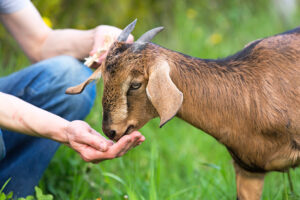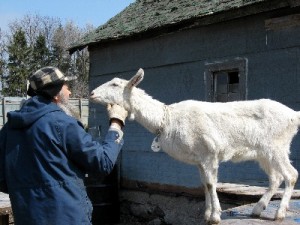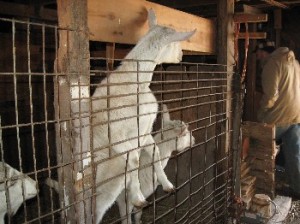People! Are your goats healthy? Your sheep? No arthritis? No hard udders that are a mystery? Are they eating well? Not just peanut butter in celery sticks; as I tell husband Norm, goats do NOT live on peanut butter alone (man does not live on peanut butter alone either, but that’s another story). Or could some of your animals have CAE? Do you even know what CAE is? Sadly, many do not; but don’t feel badly if you are one who does not. Just read on.
 CAE (not pronounced ‘kay’ but ‘C – A – E’) is the acronym for CAPRINE ARTHRITIS ENCEPHALITIS. This is a disease that is transferred by milk or by fluids. This means that if your doe has CAE, you cannot allow her kids to be nursed by her or even allow her to lick and clean the kids. Even sneezing can transfer the infection.
CAE (not pronounced ‘kay’ but ‘C – A – E’) is the acronym for CAPRINE ARTHRITIS ENCEPHALITIS. This is a disease that is transferred by milk or by fluids. This means that if your doe has CAE, you cannot allow her kids to be nursed by her or even allow her to lick and clean the kids. Even sneezing can transfer the infection.
Now, I don’t want to put fear in your hearts, but CAE is really a disease to be aware of and avoid if at all possible. Not every animal that has CAE will show signs, but one could be a carrier for youngsters to develop it. Both goats and sheep can carry and suffer from CAE, even though it’s predominant in goats. So I will not keep saying “goats or sheep” but let you change “goat” to “sheep” in your head if you wish.
CAE can have two different signs – a neurological disease in the spinal cord and brain of young kids and a joint infection of older goats resulting in arthritis.
All breeds of goats can be affected from the nervous form, as can both sexes; most individuals first show signs between one and four months of age. It will show as progressive weakness of the hind limbs leading to eventual paralysis. Early signs may look like lameness or weakness in one or both rear legs. Knuckling over of the feet and difficulty in rising may follow until such time that the animal is unable to rise at all. The course of the disease is from several days to several weeks. Despite the slow paralysis, the kid will usually remain bright and alert and continue to eat and drink. If the correct diagnosis is made, the animal is often euthanized since there is no known treatment for the condition. In older goats, a variation of the nervous form of CAE include circling, head tilt and facial nerve paralysis.
The joint form of CAE most often appears between one and two years of age. Some goats can be severely crippled within a few months while others may show only occasional lameness or stiffness for years without ever becoming completely crippled. The disease is usually first recognized as a gradually developing lameness accompanied or followed by swelling of the joints. Swelling is most often noted in the front knees and can also be seen in the hock and stifle joints. As the condition progresses, joint pain and stiffness become more apparent. The animal may spend a good deal of time lying down, will begin to lose weight and develop a rough hair coat. In severely affected joints, the range of motion may become limited and goats are forced to walk around on their knees. No specific cure is known for CAE arthritis. The well-being of affected goats may be improved by proper foot trimming, extra bedding and administration of anti-inflammatory drugs such as aspirin.
 Now, I will be honest with you – I knew of CAE when I first purchased sheep for Historic Murphy’s Landing. The previous owner of my lambs suggested I have the old Angora goats tested and have the animals kept separate in case the goats had CAE. But I was carefree and careless and felt it wouldn’t matter. There was no description of the disease and no real warnings of the dangers.
Now, I will be honest with you – I knew of CAE when I first purchased sheep for Historic Murphy’s Landing. The previous owner of my lambs suggested I have the old Angora goats tested and have the animals kept separate in case the goats had CAE. But I was carefree and careless and felt it wouldn’t matter. There was no description of the disease and no real warnings of the dangers.
When I look back at our old Angora goats, I feel they probably did have CAE, as they became very crippled as they got older and most of them were unable to get up by themselves. I had put it as copper poisoning as I had been warned to not give copper supplements to the sheep. The previous caretaker at Murphy’s had been feeding the horse and goats a feed that had copper supplements in it. So I assumed (not knowing sheep or goats that well) that the problems with the goats came from too much copper.
As I now know that goats need a little bit of copper and sheep cannot have it, then the copper poisoning theory has gone out the window and the goats’ problem could have been CAE. Although the goats were in good health despite the joint problems, we had to put them down, one at a time when their legs would not work and they couldn’t get up. Fortunately, the sheep never developed symptoms even though they ran together in the same pasture. However, they really had nothing to do with each other – except the ram and the biggest buck would butt heads once in a while.
However, my soon-to-be-neighbor, good friend and partner-in-crime, Jody, has purchased three beautiful young Saanen doelings. She purchased them from a reputable breeder who sold them at one-third the price because they had tested positive for CAE. This breeder had been CAE free until this past year when she purchased a doe from another breeder who had promised the new doe was CAE free. Unfortunately that doe was infected and the breeder now has CAE running rampant in her herd.
Jody has a plan, though, that I hope to help her with. CAE does not affect humans (repeat – does NOT affect humans!). The milk can be drunk and used for any purpose and will not harm humans or any animals except sheep or other goats.
The three doelings will be bred when they are of age, probably artificially, to protect the buck, and then watched carefully at birthing time. We will be sure to keep the kids from any contact from the mother immediately after birth. Jody plans on taping the teats of the momma before kidding so that if the babies are born during the night, they will not be able to nurse. (Norm wants to use duct tape – go figure!). The kids will be cleaned and warmed by humans, not by the mother. They will be fed with powdered colostrum and kid feeder and kept totally separate from momma. Since CAE is transferred by “body fluids” (like human AIDS), this should ensure that the kids would be CAE free. If that is the case, then Jody will have a herd of beautiful Saanen does that can be tested to be CAE free. Having your vet draw a blood sample and the serum tested for the virus is the best way to find out. Jody plans on having that done to her new kids when they are about six months of age. And in the meanwhile, she will keep everyone separate; we will all be keeping our fingers and eyes crossed!
The older does will be kept totally separate from the others and watched carefully. If they do not develop any symptoms, they can live happy carefree lives; if they do develop symptoms that make their lives miserable, then they will be put down by loving hands.
 They will also have to be kept separate from any sheep that Jody has. This does not mean kept in a pen or pasture next to the other animals. Any infected animal must be kept far enough away so that noses do not touch; since goats tend to sneeze a bit, even sneezing distance must be avoided.
They will also have to be kept separate from any sheep that Jody has. This does not mean kept in a pen or pasture next to the other animals. Any infected animal must be kept far enough away so that noses do not touch; since goats tend to sneeze a bit, even sneezing distance must be avoided.
I understand, according to statistics, that about seventy percent of the herds in America are not tested for CAE. If you feel you are in danger of this, you can have your herd tested. If you are certain that you are CAE free, then I suggest any new member of your herd be tested before being put in with the others. A small herd of one or two does shouldn’t be a problem, but I would be sure to have the buck CAE free if you can. If you think your does have CAE, then I would isolate your kids from the does to be on the safe side.
As it has been mentioned, some animals do not show signs at all, and some show mild signs that could also be just plain arthritis. But I would not want any animal to suffer as I watched our Angoras suffer, even though we didn’t know what the problem was. And sheep CAN be infected and have the same problems as goats.
CAE is not curable! The only cure is to cull the infected animals and begin again. If you are careful, you can start over, as Jody is planning with youngsters from her own herd, using isolation as the “cure.” And if you are lucky, any CAE carrier will only suffer slight symptoms.
So, look at your goats (and sheep) closely and make your decision. Are you going to have everyone tested right away? Are you going to be casual and say, “what will be will be”? Are you going to take the middle ground and make decisions that are best for you and your animals? The decision is yours and only yours to make. But hopefully I have opened your eyes to the problem so you can do further research and make a decision with knowledge on your side.
































my experience with CAE was a doe having quads and i bottle fed them all. if i knew what was what, i would have seperated them all and started a CAE free herd. i knew a lady who had nubians and she milked her mommas, pastureized the milk and fed it back to the babies. it saved alot of money.
our goats did not show much of a sign with exception of snapping joints like a bone creak or something. they were happy and full of — well goat getting into everything and not bothered by anything.